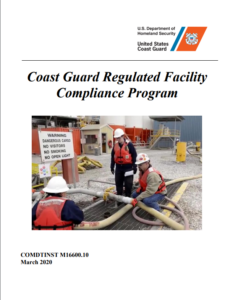The United States Coast Guard (USCG) published the “Coast Guard Regulated Facility Compliance Program Manual” to consolidate overarching guidance, policy, and doctrine for Coast Guard personnel responsible for the administration and performance of the regulated facility compliance program.
The manual is for all Coast Guard unit commanders, commanding officers, officers-in-charge, deputy/assistant commandants, and chiefs of headquarters staff elements, who must comply with the provisions of this Manual, according to the USCG.
Also, the manual includes facility compliance information from external sources, such as Marine Safety Manual Vol. II, directives, and policy letters, while also formalized existent best practices and provides amplifying information to Coast Guard personnel on oversight and management of facility compliance programs and activities conducted as part of those programs.
The manual is focused on Marine Safety, Marine Environmental Protection, and Port and Waterways Security.
Within the context of these three missions, the Coast Guard inspects waterfront facilities for safety and security requirements to prevent accidents or intentional acts that could cause death and injury, the spill or release of oil or hazardous material into the environment, or a disruption to the Marine Transportation System. In some instances, facility compliance activities also have a nexus to a fourth statutory mission, Defense Readiness.
Except regulations, the manual focuses on the safety of the inspectors, keeping in mind that many of the cargoes or products handled at waterfront facilities are explosive, flammable, or present an inhalation or other health hazard.
Therefore, it is advisable that all inspectors are equipped with the Personal Protective Equipment (PPE). Thus, when conducting facility compliance activities, basic PPE must include: a hard hat, safety glasses, hearing protection, safety shoes, and leather gloves for abrasion hazards. When practical, long sleeve work attire or coveralls should also be worn to help provide protection
from sun exposure, abrasion, cold temperatures and contact with chemical hazards. Noise that exceeds 85 decibels (dB) or has a peak of 140 dB or greater requires hearing protection. A best practice is to wear hearing protection at any location where personnel must raise their voices to communicate.
For more information on the manual click here































































